In addition to our primary Methods & Processes, we have several more basic tools that we use in our work with clients and within our various workshops. Some of these are unique to Legacy Innovation Group, while others belong to the open domain of tools known as Design Methods. Through years of study and practice, we have mastered each of these tools. We know just the right tool to pull out for a particular need, and we know how to apply each one effectively. With this many tools, no two problems ever look alike.
To jump ahead to any one of these tools, please select from the following list:
We created the Legacy Innovation Solution Space Canvas because we were dissatisfied with the value proposition canvases being used elsewhere. In our experience, the Solution Space (and thus the Value Proposition) must derive from the Jobs–To–Be–Done (JTBD – from Outcome–Driven Innovation), and all of the needs must therefore fall out of this, including both the PAINS (to be relieved) and the GAINS (to be created if possible and needed).
Furthermore, PAINS should be addressed first and prioritized over GAINS (and so we have arranged them in this order vertically). The reason for this is because, psychologically, customers often have a much more profound and visceral reaction (exuberant, joyful reaction) to having their PAINS relieved than they do to having new GAINS given to them, depending of course on the relative strengths of the particular PAINS and GAINS. All else being equal, relieving a PAIN will usually create more market response and sales traction than will offering a "new and improved" GAIN. Furthermore, offering a GAIN without first relieving an important PAIN will almost always end in customers not recognizing the GAIN, as they cannot get past the PAIN to even be at that point of benefiting from the GAIN. That being said, the best solutions will consistently deliver on both of these and get paid for them.
Finally, by incorporating into this canvas the fundamental "Needs & Motivations" of the customer, it drives an empathic alignment in the solution, in keeping with good Human Centered Design practice. This insures the solution understands the WHYs behind the JTBD, together with their relative importance, and how it therefore addresses these underlying needs and motivations. This can sometimes be a subtle insight that actually yields a much different solution than would otherwise be conceived.
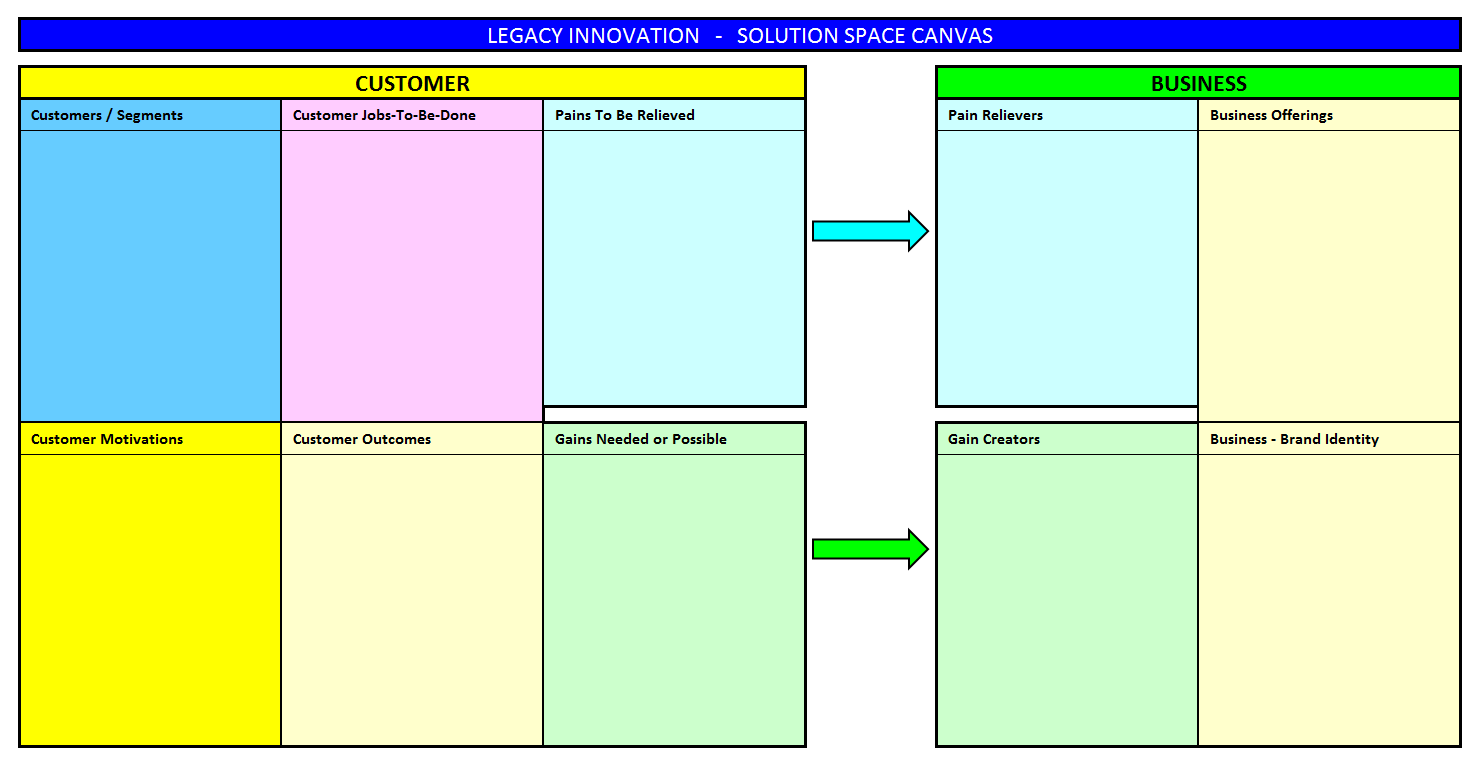
We use the Legacy Innovation Solution Space Canvas within a number of our workshops, including Business Model Expedition, Strategic Inquiry, and Frontline Innovation Workshops.
We created the Legacy Innovation Business Model Canvas because we were dissatisfied with the business model canvases being used elsewhere. Other canvases tend to lay out the model in ways that don't follow the flow of how market–driven businesses are designed. They have much of the model arranged backwards, forcing users to have to think backwards.
In our canvas, we always begin with the WHO first. Only then do we talk about the WHAT. And subsequent to that we talk about how to bridge the two together through CHANNELS, CUSTOMER RELATIONSHIPS, and the BRAND PROMISE. Similarly, we first need to understand REVENUE STREAMS before we should care about COST STRUCTURES. The difference here may seem subtle to the novice, but to the trained eye, they will recognize that this is the difference between being a "solution–pushing" business and a "need–finding" business.
Finally, by incorporating into this canvas the fundamental "Needs & Motivations" of the customer, it drives an empathic alignment in the business model, in keeping with good Human Centered Design practice. This insures the business model understands the WHYs behind the value proposition, together with their relative importance, and how it therefore addresses these customer needs and motivations. This can sometimes be a subtle insight that actually yields a much different business model than would otherwise be conceived.
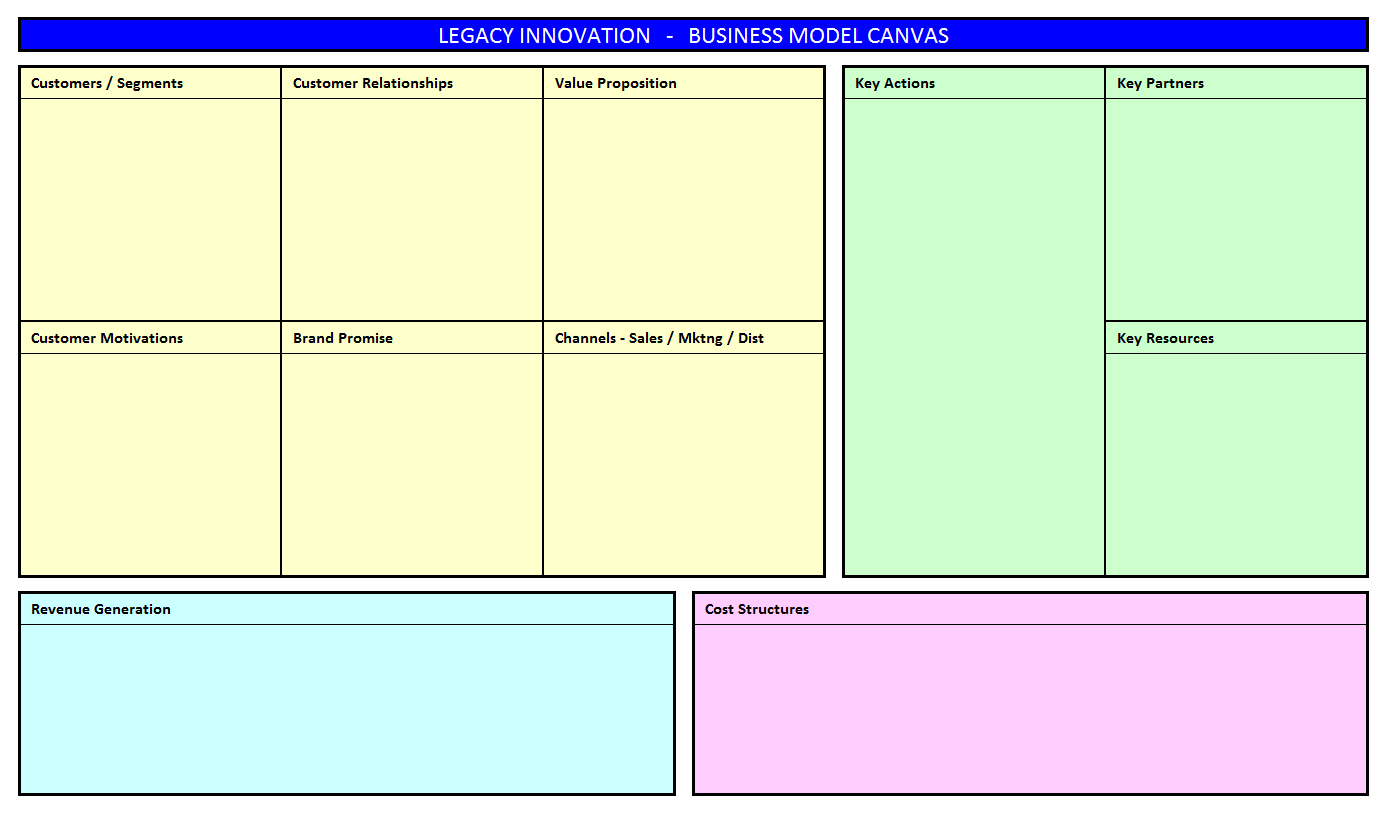
We use the Legacy Innovation Business Model Canvas within a number of our workshops, including Business Model Expedition, Strategic Inquiry, and Frontline Innovation Workshops.
The Legacy Innovation Customer Experience Journey Map (CXJM) is our own version of the generic CX journey map. It allows us to capture everything germane to designing and staging great customer experiences. Its use is rooted in our in-depth understanding of Experience Psychology.
The Legacy Innovation CXJM begins with capturing certain key inputs, including:
Inside the mapping process, the CXJM allows us to fully capture and dissect each touchpoint of the experience, including the following items:
In addition to the mapping of the experience, a number of other key outcomes are captured, including:
The Legacy Innovation CXJM is a highly effective tool. Using this tool, we are able to map out all of the relevant details for each touchpoint of a given experience. As such, it can be used to either map out and analyze an existing "as–is" experience, or to design a completely new "to–be" experience. Ultimately, it allows us to define the Moments of Truth that engage customers deeply with brands, and to create the experiences that will capture and lead markets.
For more details on our process for designing innovative new experiences, see The Legacy Innovation Experience Design Process.

We use the Legacy Innovation Customer Experience Journey Map when undertaking Experience Innovation projects.
The Legacy Innovation Product Experience Framework (PX Framework) is a tool we use to translate a desired customer experience (at each touchpoint) into corresponding attributes for the new product, service, or business model we are designing.
In the parlance of Design Methods, it is what is known as an Alignment Model.
Using this tool allows us to pursue our unique design philosophy – the Designed Experience Approach. This philosophy – a key foundation of our design process – dictates that a product, service, or business model design cannot be considered complete until all of the relevant customer experience attributes have been fully captured and translated into corresponding product, service, or business model attributes. This ensures these are designed so that they will, in fact, deliver on their part of the overall customer experience.
Within the PX Framework, the following details are captured for each touchpoint:
Of particular importance are the target attribute values for each event. These serve as key metrics against which competing designs can be evaluated further downstream in the design process.
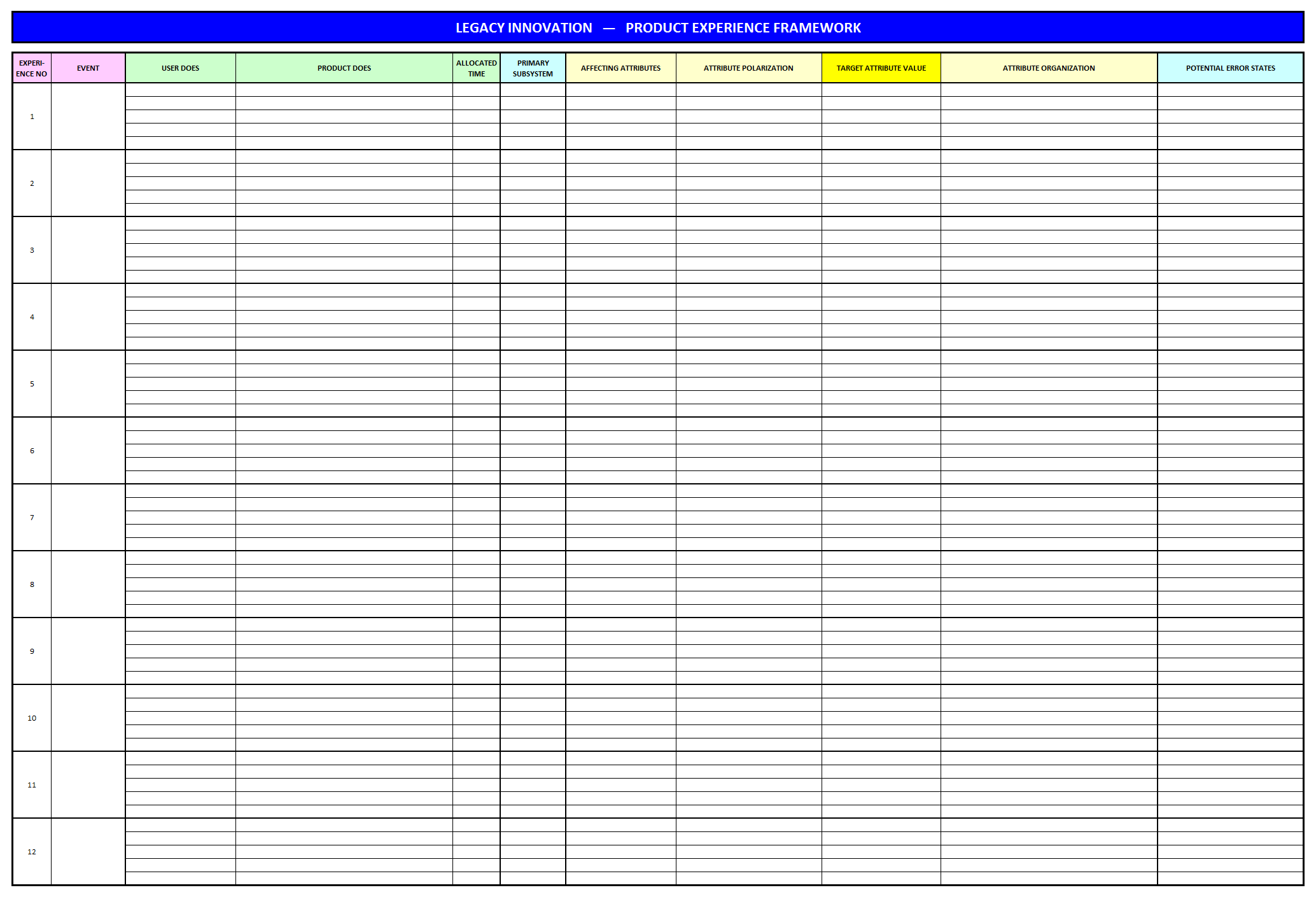
We use the Legacy Innovation Product Experience Framework when undertaking Product Innovation, Service Innovation, and Business Model Innovation projects.
The Legacy Innovation Service Model Framework (SM Framework) is a tool we use to capture the key attributes of a particular service innovation we are designing.
It allows us to ensure the service innovation is designed to achieve its key objectives and to do so in a way that delivers the intended brand experience.
Within the SM Framework, the following details are captured for the new service:
Of particular importance are the target KPIs established for how the service is to be delivered and received, and the outcomes and results that are to be produced as a result of that. These serve as key metrics against which competing service designs can be evaluated further downstream in the design process.
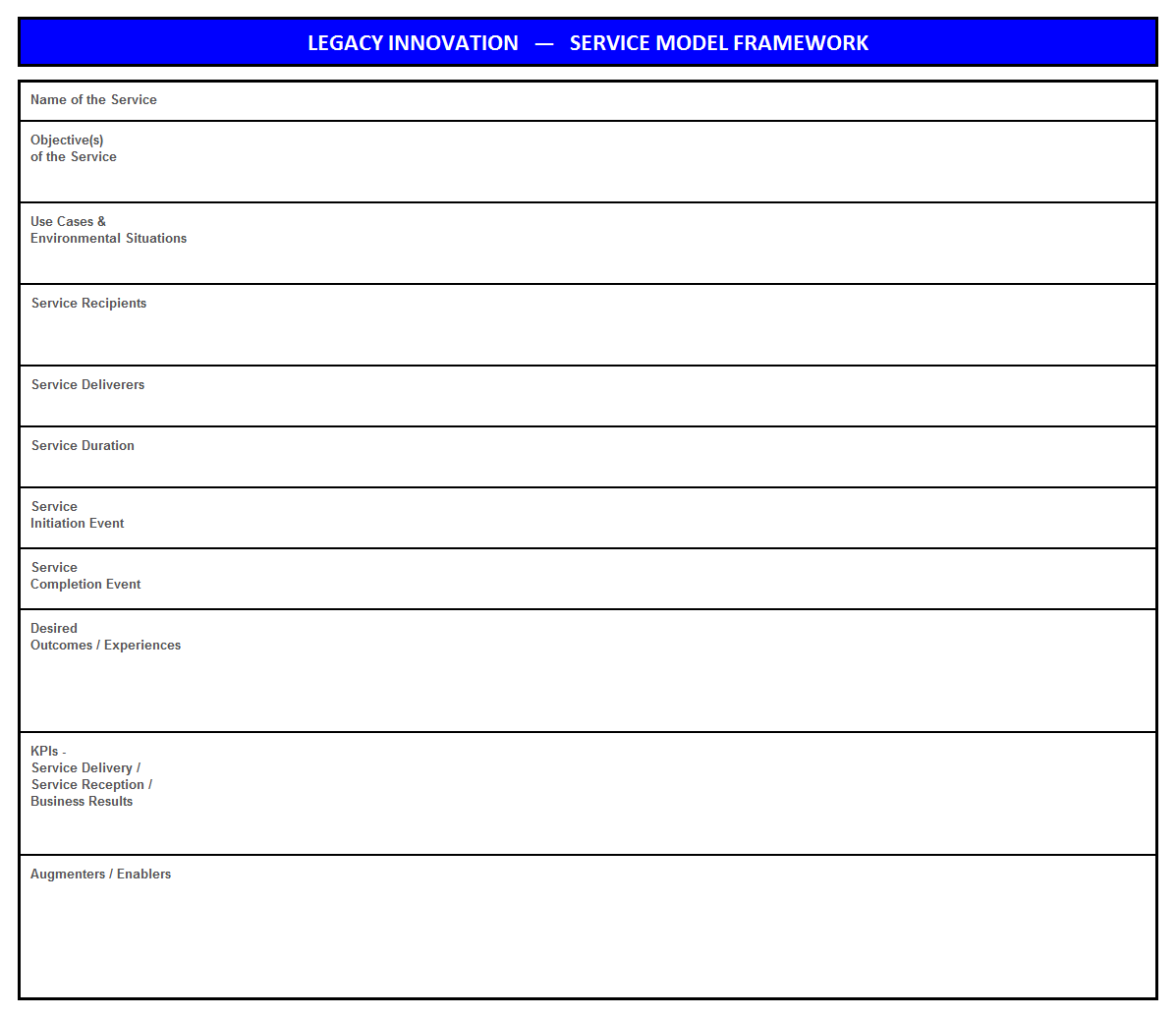
We use the Legacy Innovation Service Model Framework when undertaking Service Innovation projects.
The Legacy Innovation Service Blueprint (SBP) is our own version of the generic service blueprint. It allows us to model the entire flow of actions and interactions occurring between customers, front-stage staff, and back-stage staff, including in the latter case those involved in live support processes and those involved in a priori planning processes.
By so modeling the service flow, we are able to understand – with a high degree of precision – exactly what is demanded of each front-stage and back-stage staff member at each respective external (customer) touchpoint and/or internal action point... each person's explicit actions, the interactions and exchanges that must occur between them, and how these must occur in order for the service to be delivered to the intended and desired standard of brand experience.
What this often reveals in experimenting with different service designs is the respective pain points and obstacles within the internal organization that will prevent it from delivering the service as intended and desired. We can then iterate on the service design until we have found new ways to eliminate and/or overcome these issues.
The blueprint also lets us have a conversation around the level of staff autonomy we wish to allow, versus the level of service homogeneity and standardization we desire, with differing strategies placing differing demands on the types of service provider staff engaged for each situation.
Within the Service Blueprint, the following details are captured for each respective step in the new service:
Within this model are also four critical lines of demarcation. In particular are...
Of particular importance here is ensuring, without any doubt remaining, that the organization is 100% fully capable of delivering each and every step of this service process – each front-stage action, each back-stage action, each support process, each planning process, and each enabling technology – required to deliver each step of this service as intended and desired. This will require that the delivery of this service be prototyped and trialed so as to validate this and ensure the necessary level of confidence. In this way, the entire design / validation cycle can be iterated in loops until the organization is fully satisfied that it has arrived at a new service design which it can in fact deliver with the intended outcome.
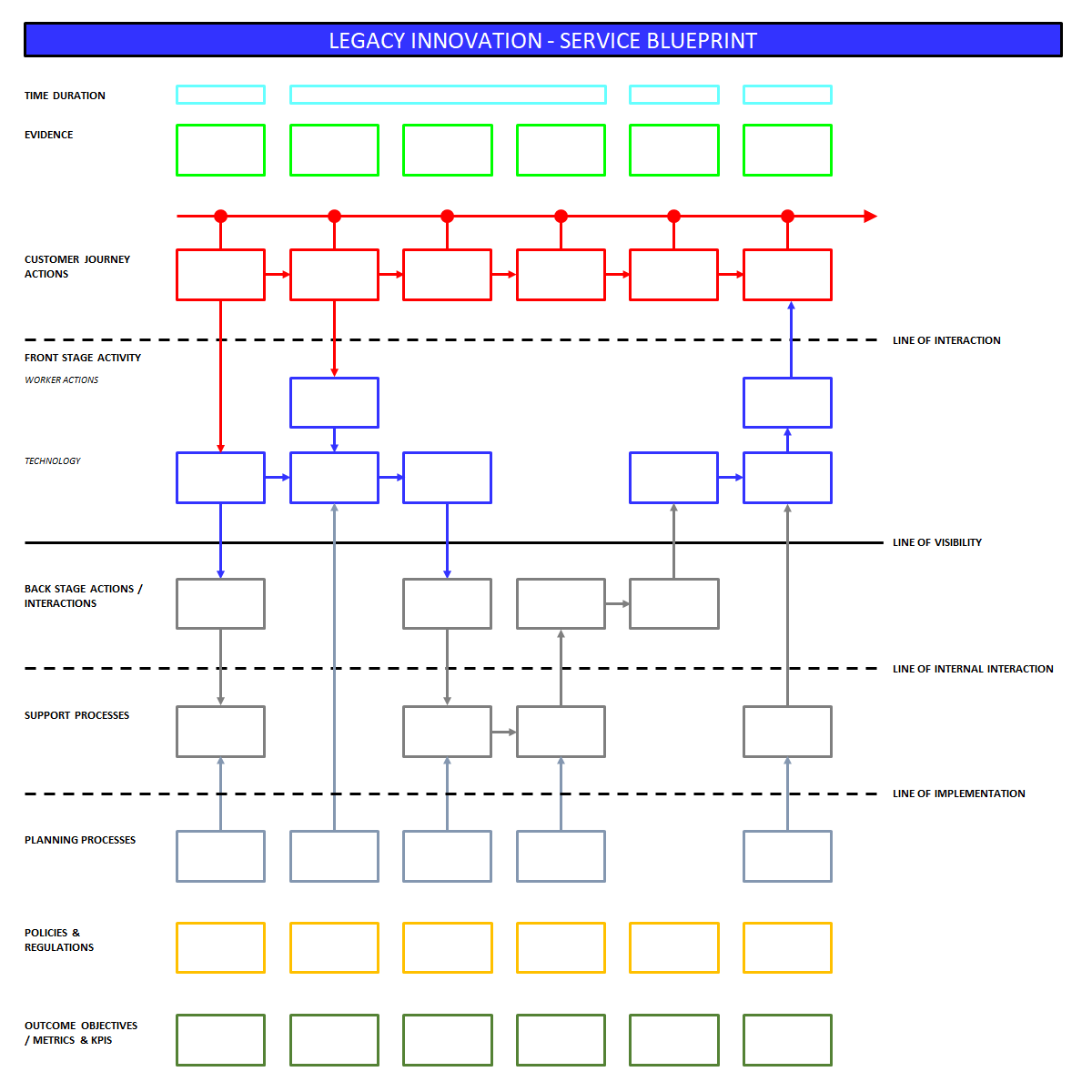
We use the Legacy Innovation Service Blueprint when undertaking Service Innovation projects.
In addition to our own proprietary tools and methods, we routinely make use of a large arsenal of Design Methods (these are the user-centric research & analysis methods associated with Design Thinking). Here is a listing of some of the more important Design Methods we use...
The tools shown here enable and augment the discovery and design work we do in association with our Discovery and Design Practices, including for Product Innovation, Service Innovation, Experience Innovation, and Business Model Innovation. To learn more about any of these, see either our Discovery Practice page or our Design Practice page. To engage us for any of these services, please refer to our Engagement page.
These tools also serve a large number of uses inside of our workshops. To learn more about this, see our Workshops & Fieldwork Events page, or to engage us to conduct any of these workshops, please refer to our Workshops Engagement page.

CEOs come and CEOs go. Some are excellent. They generally ‘get it’. Others not so much. They really ‘don't get it’. What makes the difference between these?
READ MORE
There's an insidious debate that's bounced around for probably the better part of twenty years now. It's the debate of whether or not ‘innovation is everyone's job’...
READ MORE
Innovation Spaces – which can refer to any space intentionally designed to foster and facilitate good innovation work – come in all sorts, shapes, and sizes...
READ MOREWe partner with committed business leaders to make their organizations the driving forces in their markets.
CONTACT USSign up for our newsletter.
NEWSLETTER SIGN-UP